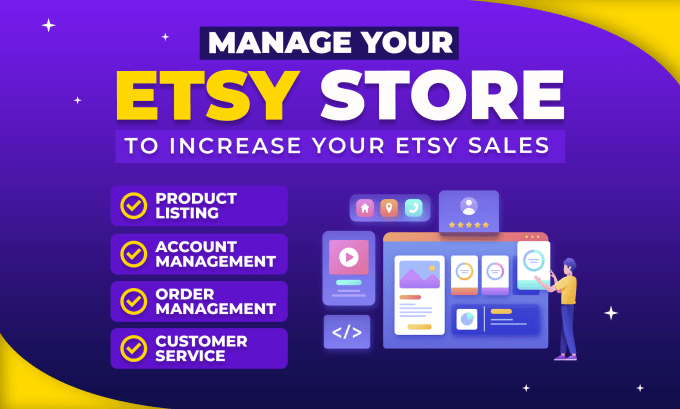Etsy shop is an online marketplace where individuals can sell handmade, vintage, and unique goods directly to customers around the world. Launched in 2005, Etsy has grown into a thriving community of artisans, crafters, and entrepreneurs, providing a platform to showcase their talents and connect with buyers who appreciate craftsmanship and creativity.
Etsy represents more than just an online marketplace; it is a vibrant community where artisans, crafters, and entrepreneurs come together to showcase their talents and connect with buyers who appreciate craftsmanship and creativity.
At its core, Etsy embodies the spirit of entrepreneurship, offering a platform for individuals to turn their creative passions into profitable businesses. But what makes Etsy truly important and why should you consider starting your Etsy shop? First and foremost, Etsy provides a global reach, allowing sellers to connect with customers from around the world.
This level of exposure is invaluable for small businesses looking to expand their reach beyond local markets. Whether you’re selling handmade jewelry, vintage clothing, or personalized home decor, Etsy’s extensive customer base ensures that your products have the potential to reach a diverse audience of buyers.
Moreover, Etsy offers a level playing field for sellers of all backgrounds and experience levels. Unlike traditional retail channels, where established brands often dominate the market, Etsy gives independent sellers a platform to compete on merit rather than marketing budget.
This democratization of commerce empowers individuals to succeed based on the quality of their products and the strength of their brand, rather than the size of their operation. Additionally, Etsy provides sellers with valuable tools and resources to help them succeed.
From customizable shop profiles and product listings to built-in analytics and marketing features, Etsy equips sellers with everything they need to effectively manage and grow their businesses. This level of support and guidance is particularly beneficial for first-time sellers who may be unfamiliar with the intricacies of e-commerce.
Beyond its practical benefits, Etsy fosters a sense of community among its users. Sellers have the opportunity to connect with fellow entrepreneurs, share insights and advice, and collaborate on projects. This sense of camaraderie creates a supportive environment where sellers can learn from each other’s experiences and inspire one another to reach new heights of success.
Moreover, Etsy’s commitment to sustainability and ethical business practices sets it apart from other online marketplaces. With a focus on handmade, vintage, and eco-friendly products, Etsy encourages sellers to embrace environmentally conscious practices and promote responsible consumption.
This alignment with values such as sustainability and ethical production resonates with today’s socially conscious consumers, further enhancing the appeal of Etsy as a platform for both buyers and sellers. In essence, Etsy represents an opportunity for creative individuals to pursue their passions, build thriving businesses, and make meaningful connections with customers and fellow entrepreneurs alike.
Read Also: Reasons Why You Should Venture Into Affiliate Marketing
Step-By-Step Guide on How to Start An Etsy Shop
Embarking on the journey of starting your own Etsy shop can be both exhilarating and daunting. However, with the right guidance and approach, you can turn your creative passion into a successful online business. This step-by-step guide will walk you through the process of setting up your Etsy shop, from initial research to attracting your first customers.
1. Research and Planning: Before diving into the world of Etsy entrepreneurship, take the time to research the market and identify potential niches or product categories that align with your skills and interests.
Explore existing Etsy shops to understand what sells well and where you can carve out your own unique space. Consider factors such as target audience, competition, pricing, and trends to inform your decision-making process.
2. Define Your Brand Identity: Creating a strong brand identity is essential for standing out in the crowded marketplace of Etsy. Choose a memorable shop name that reflects your style and offerings. Design a captivating logo and craft a compelling brand story that resonates with your target audience. Consistency in branding across your shop, product listings, and social media channels will help build trust and recognition among customers.
3. Rource or Create Your Products: Whether you’re crafting handmade items or curating vintage finds, ensure that your products meet Etsy’s guidelines and standards. Focus on quality, uniqueness, and craftsmanship to attract buyers and differentiate yourself from competitors. Take high-quality photos of your products from multiple angles and in various settings to showcase their features and details effectively.
4. Set Up Your Shop: Creating an Etsy shop is a straightforward process that involves signing up for an account and following the prompts to set up your shop profile. Customize your shop’s appearance by selecting a banner, shop icon, and layout that aligns with your brand identity. Fill out all the necessary information, including shop policies, shipping details, and payment options.
5. Write Compelling Product Listings: Craft engaging product descriptions that highlight the features, benefits, and unique selling points of your items. Use relevant keywords and tags to improve your products’ visibility in Etsy’s search results. Pricing your products competitively while factoring in material costs, labor, and profit margins is essential for achieving sustainable growth.
6. Optimize Your Shop for SEO: Implementing search engine optimization (SEO) techniques can significantly impact your shop’s visibility and sales on Etsy. Conduct keyword research to identify popular search terms in your niche and incorporate them into your product titles, descriptions, and tags. Regularly update your listings and engage with your audience to improve your shop’s ranking in Etsy’s search algorithm.
7. Provide Excellent Customer Service: Building a positive reputation and fostering customer loyalty are essential for long-term success on Etsy. Respond promptly to inquiries, address customer concerns or complaints professionally, and strive to exceed expectations with every interaction. Encourage satisfied customers to leave reviews and testimonials to showcase your credibility and trustworthiness.
How to Set Up Your Etsy Shop Account

1. Sign up for an Etsy Account: To begin, visit the Etsy website and click on the “Sign Up” button located at the top right corner of the homepage. You will be prompted to create an account by providing your email address, password, and preferred username. Alternatively, you can sign up using your Google or Facebook account for added convenience.
2. Choose Your Shop Name: Once you created your Etsy account, the next step is to choose a name for your shop. Your shop name is an important part of your brand identity, so take the time to select a name that reflects your style and offerings.
Keep in mind that your shop name must be unique and not already in use by another Etsy seller. If you ever need to update it, learning how to change your shop name on Etsy is a straightforward process. To change your shop name, go to “Shop Manager,” click on “Settings,” and then “Info & Appearance.”
Here, you will see the option to change your shop name. Enter your new name and click “Save.” Note that you can change your shop name as many times as you want before you open your shop, but once your shop is open, you can only change it once.
3. Complete Your Shop Preferences: After choosing your shop name, you will need to complete a few additional preferences to personalize your shop. This includes selecting your preferred language, currency, and country of residence. You will also have the option to customize your shop’s appearance by adding a banner, shop icon, and profile photo.
4. Set Up Your Shop: Once you completed your shop preferences, you can proceed to set up your shop. Click on the “Open Your Etsy Shop” button to begin the setup process. You will be guided through a series of steps to fill out important information about your shop, including shop language and currency, Shop title, shop announcement, and shop policies.
5. Add Your Listings: With your shop set up, it is time to start adding listings for your products. Click on the “List a New Item” button to create a new listing. You will be prompted to upload photos of your product, write a compelling title and description, set a price, and choose relevant tags and categories. Be sure to provide accurate and detailed information about your products to help customers make informed purchasing decisions.
6. Preview and Publish Your Listings: Before publishing your listings, take the time to preview them to ensure everything looks good. You can make any necessary edits or adjustments before clicking the “Publish” button to make your listings live in your shop. Once published, your listings will be visible to Etsy shoppers and available for purchase.
Read Also: How to Locate Best Shops Near Me
Guide on Listing your Products on Esty Shop

Listing your products on your Etsy shop is a fundamental aspect of running a successful e-commerce business. It’s the primary way you showcase your offerings to potential customers and entice them to make a purchase. Here is a detailed guide to help you navigate the process effectively:
1. Log In to Your Etsy Account: Start by logging in to your Etsy account using your username and password. If you do not have an Etsy account yet, you will need to sign up for one before proceeding.
2. Access Your Shop Dashboard: Once logged in, navigate to your shop dashboard by clicking on the “Shop Manager” tab at the top right corner of the page. This will take you to the central hub where you can manage all aspects of your Etsy shop.
3. Click on “Listings”: In the Shop Manager, locate the “Listings” tab and click on it to access your product listings page. Here, you will be able to view all your existing listings as well as add new ones.
4. Create a New Listing:To add a new product listing, click on the “Add a listing” button or a similar option depending on your Etsy shop’s layout. This will open up a form where you can input all the details about your product.
5. Add Product Photos: The first step in creating a compelling product listing is to upload high-quality photos of your product. Make sure the images are well-lit, clear, and accurately represent the item’s appearance, features, and details. You can upload multiple photos to showcase different angles and perspectives, giving potential buyers a comprehensive view of the product.
6. Write a Compelling Title: Craft a descriptive and engaging title for your product that captures the attention of potential buyers. Include relevant keywords that potential buyers might use when searching for similar items on Etsy. Keep the title concise but informative, highlighting the key features or benefits of the product.
7. Write a Detailed Description: Provide a detailed description of your product in the space provided. Be sure to include information about the item’s features, dimensions, materials, and any other relevant details that potential buyers might want to know. Use clear and concise language, and consider formatting the description with bullet points or paragraphs for easy readability.
8. Set a Price: Determine the price for your product based on factors such as material costs, labor, and desired profit margin. Consider researching similar items on Etsy to gauge market prices and competitiveness. Be sure to factor in any fees or commissions charged by Etsy when setting your price.
9. Select Categories and Tags: Choose relevant categories and tags to help potential buyers find your product through Etsy’s search function. Selecting the appropriate categories and tags will improve the visibility of your listing and make it easier for buyers to discover your products. Use specific and descriptive keywords that accurately represent your item and its unique features.
10. Set Inventory and Variations (if applicable): If you offer multiple variations of your product (e.g., different colors, sizes), set up inventory tracking and specify variations such as size, color, and quantity available for each option. This ensures that you can accurately track and manage your inventory and prevents overselling or running out of stock.
11. Set Shipping Details: Specify your shipping preferences, including shipping methods, processing times, and shipping costs. Provide accurate shipping information to avoid any delays or discrepancies with customer orders. Consider offering options such as expedited shipping or international shipping to cater to a broader audience.
12. Preview and Publish: Before publishing your listing, take the time to review all the information you have entered to ensure accuracy and completeness. Preview the listing to see how it will appear to potential buyers and make any necessary adjustments or edits. Once you’re satisfied with the listing, click on the “Publish” or “Save” button to make it live in your Etsy shop.
13. Monitor and Update Listings: After publishing your listings, it is essential to monitor them regularly for any changes or updates. Keep track of inventory levels, pricing, and product descriptions, and make adjustments as needed to keep your listings accurate and up-to-date. Consider periodically refreshing your listings with new photos or updated information to keep them engaging and appealing to potential buyers.
How to Manage Your Etsy Shop

Managing your Etsy shop effectively is essential for ensuring its success and growth over time. From maintaining your product listings to providing excellent customer service, there are several key aspects to consider when managing your Etsy shop.
1. Regularly Update Your Product Listings: Keeping your product listings up-to-date is crucial for attracting customers and encouraging sales. Regularly review your listings to ensure that they accurately reflect your current inventory, pricing, and product descriptions. If you add new products or make changes to existing ones, be sure to update your listings promptly to keep your shop fresh and engaging.
2. Monitor Your Inventory Levels: Maintaining adequate inventory levels is essential for fulfilling customer orders in a timely manner. Keep track of your stock levels and reorder supplies as needed to avoid running out of popular items. Consider using inventory management tools or spreadsheets to track your inventory and forecast future demand.
3. Fulfill Orders Promptly: Once you receive an order from a customer, aim to fulfill it as quickly as possible. Package the items securely and ship them out promptly to ensure a positive customer experience. Providing tracking information and communicating with customers throughout the shipping process can help build trust and confidence in your shop.
4. Provide Excellent Customer Service: Delivering exceptional customer service is key to building a loyal customer base and generating positive reviews for your shop. Respond promptly to customer inquiries and address any issues or concerns with professionalism and courtesy. Be proactive in resolving problems and strive to exceed customer expectations whenever possible.
5. Analyze Your Shop Performance: Regularly monitor your shop’s performance metrics to track your progress and identify areas for improvement. Use Etsy’s built-in analytics tools to analyze key metrics such as sales, traffic, conversion rates, and customer demographics. Pay attention to trends and patterns in your data to inform your decision-making and marketing strategies.
6.Stay Engaged with the Etsy Community: Participating in the Etsy community can provide valuable opportunities for networking, learning, and collaboration. Join Etsy teams and forums, attend local meetups and events, and connect with fellow sellers and buyers to share insights, tips, and experiences. Building relationships within the Etsy community can help you stay inspired, motivated, and informed as you manage and grow your shop.
Read Also: Ways to Maximize Your Workout Classes






